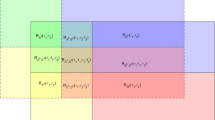Abstract
Up to now, considerable results have been concluded for two-way relaying system with linear modulations. The performance of both transmit antenna selection (TAS) and receive antenna selection (RAS) needs to be investigated in some two-way relaying multiple-input multiple-output (TWRM) systems. In this paper, the goal is to investigate the nonlinear modulations, i.e., continuous phase modulation (CPM) in TWRM systems. Firstly, it is urgent to decrease the decoding complexity of the phase states subject to various modulation index of CPM. Then, the performances of both TAS and RAS with CPM modulations in TWRM systems are analyzed and evaluated. More exactly, the pair wise probability (PEP) is used to evaluate the performance based on analysis of CPM signal matrix, which is computed in a new form of the Laurent expression. Further, the tight upper-bounds for the frame error rate (FER) are derived for CPM in TWRM systems. Finally, simulations show in good agreement with the analysis in this paper.





Similar content being viewed by others
References
Ahlswede, R., Cai, N., Li, S. R., et al. (2000). Network information flow. IEEE Transactions on Information Theory, IT-46(4), 1204–1216.
Lv, Y., He, Z. Q., & Rong, Y. (2021). Two-way AF MIMO multi-relay system design using MMSE-DFE techniques. IEEE Transactions on Wireless Communications, 20(1), 389–405.
Lee, J. H., Nam, S. S., & Ko, Y. C. (2020). Outage performance analysis of two-way full-duplex DF relaying networks with beamforming. IEEE Transactions on Vehicular Technology, 69(8), 8753–8763.
Fu, S., Lu, K., Qian, Y., et al. (2010). Cooperative wireless networks based on physical layer network coding. IEEE Wireless Communication Magazine, 17(6), 86–95.
Ju, M. C., & Kim, I. M. (2010). Error performance analysis of BPSK modulation in physical-layer network coded bidirection relay networks. IEEE Transactions on Communications, 58(10), 2770–2775.
Yang, J. H., Choi, Y. C., & Chun, J. W. (2010). Modified high-order PAMs for binary coded physical-layer network coding. IEEE Communications Letters, 14(8), 689–691.
Noori, M., & Ardakani, M. (2012). On symbol mapping for binary physical-layer network coding with PSK modulation. IEEE Transactions on Wireless Communications, 11(1), 21–26.
Chang, R. Y., Lin, S. J., & Chung, W. H. (2013). Symbol and bit mapping optimization for physical-layer network coding with pulse amplitude modulation. IEEE Transactions on Wireless Communications, 12(8), 3956–3967.
Namboodiri, V., Venugopal, K., & Rajan, B. S. (2013). Physical layer network coding for two-way relaying with QAM. IEEE Transactions on Wireless Communications, 12(10), 5074–5086.
Muralidharan, V. T., Namboodiri, V., & Rajan, B. S. (2013). Wireless network-coded bidirectional relaying using latin squares for M-PSK modulation. IEEE Transactions on Information Theory, 59(10), 6683–6710.
Yu, Q. Y., Zhang, D. Y., Chen, H. H., et al. (2016). Physical layer network coding systems with MFSK modulation. IEEE Transactions on Vehicular Technology, 65(1), 1–10.
Sha, N., Gao, Y. Y., Yi, X. X., et al. (2014). Joint CPFSK modulation and physical-layer network coding in two-way relay channels. IEICE Transactions on Fundamentals of Electronics Communications and Computer Sciences, E, 97A(4), 1021–1023.
Zhang, S., & Liew, S.C., (2010). Physical layer network coding with multiple antennas. In: Proceedings of IEEE WCNC, (pp. 1–6).
Toshiaki, K. A. (2010). Adaptive network coding in two-way relaying MIMO systems. GlobeCom, 2010, 1–9.
Vijayvaradharaj, T. M., & Rajan, B. S. (2013). Wireless network coding for MIMO two-way relaying. IEEE Transactions on Wireless Communications, 12(7), 3566–3577.
Kumar, V., Cardiff, B., & Flanagan, M. F. (2019). User-antenna selection for physical-layer network coding based on Euclidean distance. IEEE Transactions on Communications, 67(5), 3363–3375.
Mahdavi, A., Keshavarz-Haddad, A., & Jamshidi, A. (2021). Joint relay selection and opportunistic physical layer network coding for two-way relay channels. Wireless Networks. https://doi.org/10.1007/s11276-020-02534-6
Aulin, T., & Sundberg, C.-E.W. (1981). Continuous phase modulation-part I: Full response signalling. IEEE Transactions on Communications, 29(3), 196–209.
Maw, R.L., (2017). Space time coded systems with continuous phase modulation. PhD thesis, Canterbury University.
Mesleh, R., Renzo, M. D., Haas, H., et al. (2010). Trellis coded spatial modulation. IEEE Transactions on Wireless Communication, 9(7), 2349–2361.
Basar, E., Aygolu, U., Panayirci, E., et al. (2011). New trellis code design for spatial modulation. IEEE Transactions on Wireless Communication, 10(8), 2670–2680.
Zhang, X. X., & Fitz, M. P. (2003). Space-time code design with continuous phase modulation. IEEE Journal on Selected Areas in Communications, 21(5), 783–792.
Zajic, A.G., & Stüber, G.L., (2007). A space time code design for partial response CPM: Diversity order and coding gain. IEEE International Conference on Communication, Glasgow USA, (pp. 719–724).
Laurent, P. A. (1986). Exact and approximate construction of digital phase modulation by superposition of amplitude modulated pulses. IEEE Transactions on Communication, 34(2), 150–160.
Mengali, U., & Morelli, M. (1995). Decomposition of M-ary CPM signals into PAM waveforms. IEEE Transactions on Information Theory, 41(5), 1265–1275.
Proakis, J. G. (2000). Digital communications (4th ed.). New York: McGraw-Hill.
Robert, W., Heath, R. W., Sumeet, S., et al. (2001). Antenna selection for spatial multiplexing systems with linear receivers. IEEE Communications Letters, 5(4), 142–144.
Acknowledgements
The authors would like to thank the reviewers for their valuable comments for this paper. This work is supported in part by the Natural Science Foundation of Fujian Province (2020J01711), Li Shangda Discipline Construction Fund (ZC2016008), and Research Start-up Fund of Jimei University (ZQ2019021).
Author information
Authors and Affiliations
Corresponding author
Additional information
Publisher's Note
Springer Nature remains neutral with regard to jurisdictional claims in published maps and institutional affiliations.
Rights and permissions
About this article
Cite this article
Guowei, L., Yuanan, L. Performance Analysis of TAS and RAS with CPM Modulation in Two-way Relaying MIMO Systems. Wireless Pers Commun 119, 2775–2786 (2021). https://doi.org/10.1007/s11277-021-08364-9
Accepted:
Published:
Issue Date:
DOI: https://doi.org/10.1007/s11277-021-08364-9




